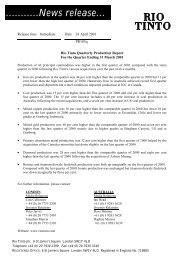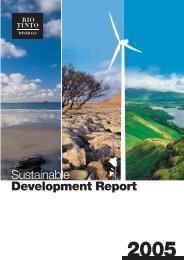Luzenac - Rio Tinto
Luzenac - Rio Tinto
Luzenac - Rio Tinto
Create successful ePaper yourself
Turn your PDF publications into a flip-book with our unique Google optimized e-Paper software.
Managing<br />
the environment<br />
responsibly<br />
Flashing light system powered<br />
by photovoltaic cells.<br />
<strong>Luzenac</strong> Set, our Spanish<br />
operation, has recently replaced<br />
its fuel-powered forklifts by electric<br />
forklifts. This not only reduces<br />
greenhouse gas emissions,<br />
it minimises health risks for<br />
employees.<br />
10<br />
<strong>Luzenac</strong>’s Health, Safety, Environment and<br />
Communities policy requires that we “be a steward<br />
of the environment and the natural resources<br />
under our responsibility and be a respected member<br />
of the community wherever we operate”.<br />
It also requires that we “build from a foundation of regulatory<br />
compliance with consistency in standards, practices<br />
and procedures worldwide”. This means that we<br />
have an integrated view of environmental management<br />
and community responsibility. Our primary aim<br />
is to operate our business with the minimum of environmental<br />
damage and to work with our neighbours<br />
to ensure we are not causing them problems.<br />
ISO 14000<br />
Last year, we set a target for all<br />
our operations to be certified to<br />
ISO 14000. By year-end, two<br />
operations, Mexico and Australia, remained uncertified.<br />
Both are now operating to environmental management<br />
systems compliant to ISO 14000 and will<br />
have their certification audits in 2003. This means<br />
that all our operations are now managing environment-related<br />
matters in a manner that is planned,<br />
controlled, monitored and recorded in compliance<br />
with an internationally acknowledged Environmental<br />
Management System.<br />
The auditing process covers whether landscape rehabilitation<br />
is planned for and carried out progressively,<br />
and is commensurate with the nature of the operation;<br />
and whether the landforms created are stable<br />
and safe and allow for a development of the land<br />
which is consistent with company and stakeholder<br />
expectations and regulatory requirements. The auditors<br />
also check that our resources are used in a sustainable<br />
manner, and that all generated waste is<br />
minimised, handled safely, treated and disposed of<br />
in a suitable way.<br />
These audits are all performed by trained auditors<br />
from all operations and from different backgrounds.<br />
This not only ensures that our operations come under<br />
the scrutiny of an impartial eye, but that experience<br />
and best practice are shared within the group.<br />
Exploring new energy sources<br />
A new goal for us is to explore the use of more renewable<br />
(“green”) energy sources such as wind and solar<br />
to meet at least some of our electricity needs. We<br />
have already started this in a very modest way at our<br />
The former tailings area of our Johnson<br />
Mill in Vermont is now a recreational area<br />
featuring a soccer field, three baseball<br />
fields and a children’s playground.<br />
Trimouns mine in the Pyrenees, which now uses solar<br />
energy to power the flashing light system used to warn<br />
drivers on the road to the mine that one of our cableway<br />
buckets is about to pass overhead. These lights<br />
are operated 24 hours a day by photovoltaic cells.<br />
Originally powered by batteries, this solution is not<br />
only environmentally friendly, it is cheaper.<br />
Land management:<br />
a key issue for <strong>Luzenac</strong><br />
The mining and processing of talc is relatively benign<br />
from an environment perspective. Our key environmental<br />
issue is land management–even in this<br />
department we are very fortunate in that we have<br />
very little unwanted rock mixed in with the talc that<br />
has to be separated and discarded. This is added to<br />
the overburden and generally used for landscaping,<br />
creating visual and noise barriers and to rehabilitate<br />
the land we have disturbed.<br />
The restoration schemes we implement are designed<br />
to enhance local species and biodiversity. To help us,<br />
we engage local academics to advise us on cultivation<br />
techniques, the choice of species, where and<br />
when to plant, how to nurture and so on. This work<br />
is combined with water run-off management as the<br />
quantity and quality of water flow is directly related<br />
to these land management aspects. This water can<br />
be of great benefit to our neighbours.<br />
Great effort, therefore, goes into minimising the<br />
adverse footprint of our mines and mills and to maximising<br />
the beneficial footprint we can create. Indeed,<br />
when we investigate the acquisition of an operation,<br />
we take into consideration how we would restore<br />
the landscape once the deposit is exhausted.<br />
Take our Johnson talc mill in Vermont for instance.<br />
The mill was first opened in the late 1800s and finally<br />
closed its doors in 1991. Initially operated as a dry<br />
grind mill, in later years the previous owners installed<br />
a flotation circuit for the processing of talc for cosmetic<br />
products. With flotation came the need for tailings<br />
settling ponds–but the facility was located in a<br />
sensitive area on the banks of the Lamoille River.<br />
At the time of closure, over 19 acres of land had been<br />
utilised as tailings ponds. Although <strong>Luzenac</strong> had<br />
owned and operated the Johnson mill for less than<br />
five years when it closed, we agreed with the local<br />
community that we would reclaim the whole tailings<br />
area and turn it over to the community as a recreational<br />
area. Ten years on, there are three baseball /<br />
softball fields, a soccer field, a playground, a parking


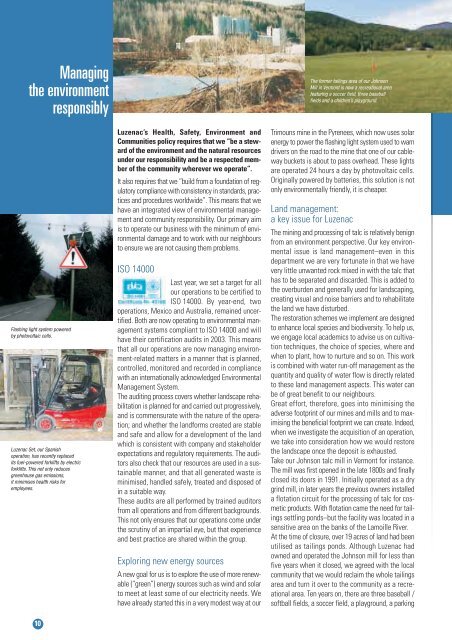
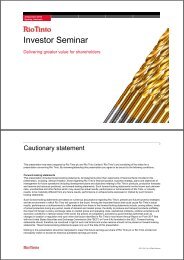


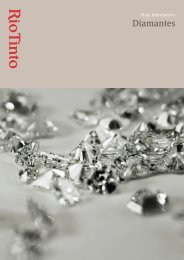

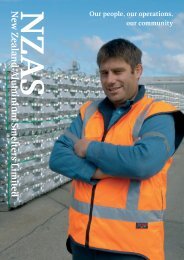
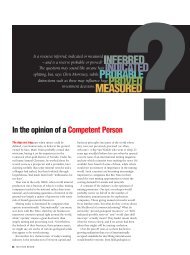
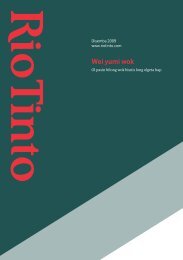
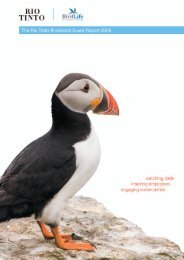
![Download pdf file [PDF: 1.26 MB] - Rio Tinto](https://img.yumpu.com/10319684/1/190x253/download-pdf-file-pdf-126-mb-rio-tinto.jpg?quality=85)

